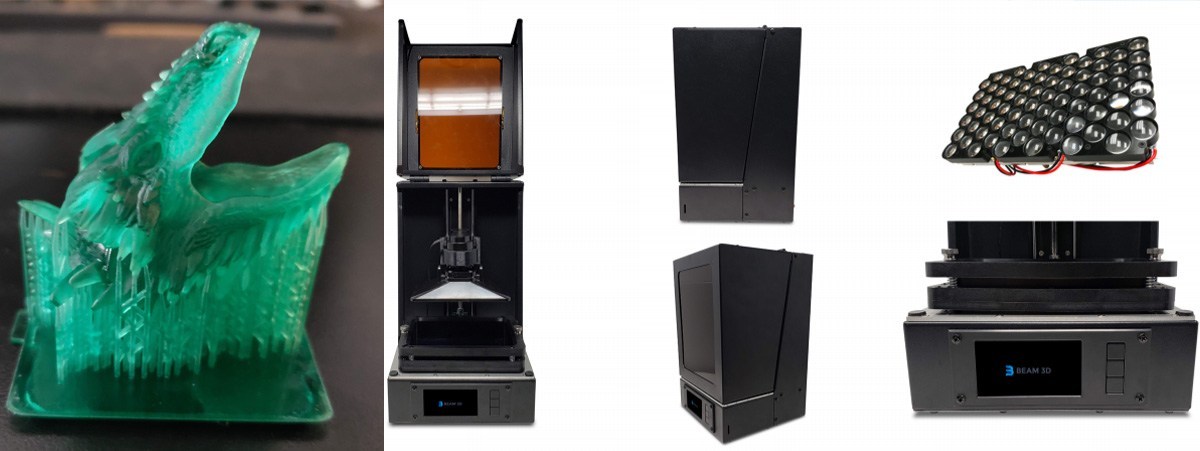 3D printing has come a long way and still has a long way to go, but from everything I’ve seen and heard, the Prism from Beam 3D makes a big leap towards making SLA resin printing both easy and affordable.
3D printing has come a long way and still has a long way to go, but from everything I’ve seen and heard, the Prism from Beam 3D makes a big leap towards making SLA resin printing both easy and affordable.
New to Kickstarter? Check out our crowdfunding primer.
Now I know a lot of people are skeptical about big tech, especially 3D printers, on Kickstarter. And when they promise as much as this, I get it and am normally as skeptical as the next person. So why not this time? One of the people who helped developed and test the build and features of the machine is someone I know and trust from his experience and expertise with 3D printing. He knows the ups and downs, pitfalls, and desires of people who live and breathe 3D printing and rely on the technology for a living (like myself). They also have a production sample 100% complete and a factory in place and lined up. While no Kickstarter is a guarantee, this is pretty much just a pre-order.
So what is the promise of the Prism? What has really drawn me in is that the Prism provides features that make it easy to use for complete novices, features that allow for more advanced use, and even fingers-in-the-guts opportunities for super users all in one machine. We’ve come to expect 3D printers to always be one or the other—easy to use, closed box, and proprietary, or open source, fully configurable, so advanced only the most dedicated can figure them out, and hard to use.
So how does the Prism make things easier for not just newbies but even experts?
- An easy to use full-color display
- Both SD card and Wi-Fi interface
- Built-in resin calibration
- Fully automatic build plate leveling
Now the first two items aren’t earth-shattering, but the second two have blown my mind. For those of you new to resin printing, almost all resin printers have a few profiles for the proprietary resin made by the printer company and leave you to your own devices for using any other resins. There is a great community around the Anycubic Photon (my current resin printer), which has compiled and constantly updated a public Google Sheet with resins, configuration settings, and test results. But it doesn’t always work right, especially because how a resin will react can change slightly just depending on the specific lot. All of that goes away with not only a ton of resin profiles built-in but the ability for the printer to analyze the resin you put into it and calibrate and configure itself appropriately!
As for auto-leveling, there is a wide variety of “auto-leveling” in the printer market. How much work you need to do yourself varies greatly, and most people agree that usually “auto-leveling” isn’t really auto when you have to do a bunch of manual work. However, the Prism promises a revolutionary, truly hands-off auto-leveling.
With these features, the Prism is truly looking to be the most user-friendly out of the box 3D printer on the market, and while it may sound too good to be true, I truly believe that it will deliver on those promises.
Now, what about the advanced features for people who want to get to the next level?
- Support for all major 3D slicers
- Real-time exposure control
- Full control of machine settings
- Full line of regular, water washable, semi-flexible, and castable resins
A lot of 3D printers on the market only work with proprietary slicers (the software that takes your 3D model and generates the code for your printer to actually print it), and in some cases, you can find a profile here or there for some printers on some slicers, but the Prism is already supported using ChiTuBox, Slic3r, Print Studio, and Creation Workshop—the major slicers most 3D printers agree are the best of the best.
The real-time exposure control is one of those advanced capabilities I personally would never have even thought about, but now that I know about it, I cannot wait to play with. And along with that, the same can be said of all of the machine settings that are controllable by the end-user—anti-aliasing levels (0,2,4,8x), movement speed, and UV power intensity. Again, all things I’d not even thought about wanting to control, but now am anxious to do so.
Okay, so all of that aside, the most important thing, of course, is the cost versus quality. And based on all of the images I’ve seen of test prints, the quality is at least as good as if not better than any SLA printer on the market that I’ve personally used or gotten prints from. These are just a few samples from D&D-sized miniatures to large multi-part models. And all at almost half the price of the next least expensive SLA printer! Even if you only wanted one of these to print off tabletop miniatures, you’d recover your costs after just a dozen or so prints (custom printed miniatures usually go for about $20 a pop).
Head over to Kickstarter and get yourself a printer starting at just $199 or bump up your pledge and get multiples, extra resin, and more!









In the market, there is a variety of 3D printers available but most promising and cost-effective in my opinion is prism from beam 3D printing. I t is more advanced,easy to use and fully configurable.
3D Printing technology spread its wings in vast manner.Following that companies are growing with various models of 3D printers.Prism SLA 3D Printer is one such which i feel after reading this content will put a mark in the field of printing technology.
In the 21st century, 3d printing had occupied a very important position in the printing technology sectors. Not only with the high-level companies, but it is also helping the small scale businesses to boom up in this sector. Prism SLA 3D Printer is one the flourishing printer available in the market which fulfills all the features required and increases the productivity.
Prism SLA 3D printer giving me the best 3D printing experience. The latest technologies have been used by them, I am very impressed with that.
Prism SLA 3D printer is a great technology that fulfills almost all the requirements for the growth in field of printing technology.